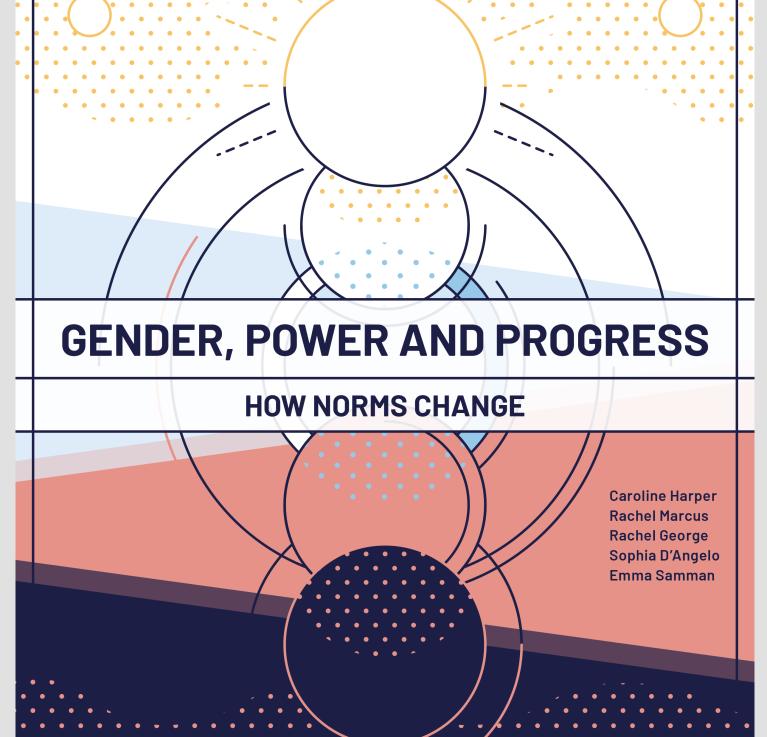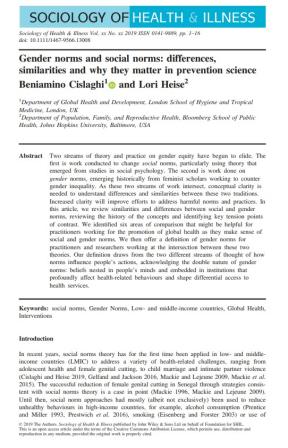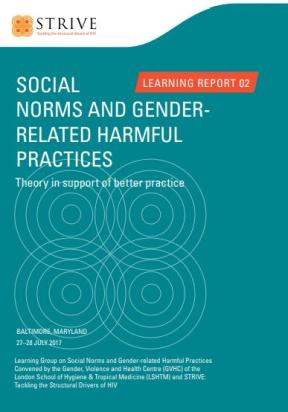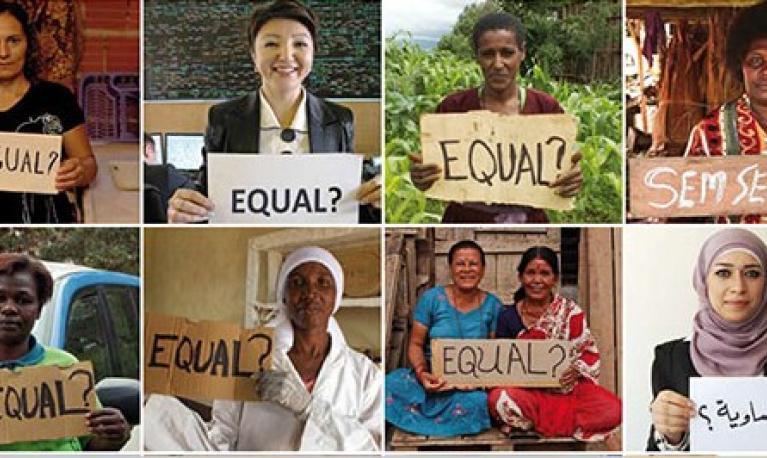
What are gender norms and how do they relate to social norms?
The terms ‘social norms’ and ‘gender norms’ are becoming more common in development research, policy and practice. While they are not new, they are used increasingly in discussions on gender equality.
In the past, norms were often ignored as ‘too complex’ to address, as an inevitable part of culture and outside the scope of development activity, or just ‘the way things have always been’. But now, social norms and gender norms are being actively addressed by actors in international development and social justice work, including those working on economic empowerment, ending child marriage, improving sexual and reproductive health and enforcing human rights law, among many other issues. This growing focus on norms is an opportunity for innovation to promote gender justice.
Social norms
Social norms are the implicit and informal rules that most people accept and follow. They are influenced by our beliefs, economic circumstances and sometimes by the rewards and sanctions we might expect for either adhering to or disobeying them. Norms are embedded in formal and informal institutions and produced and reproduced through our social interactions. They only change when enough of us choose, or are compelled, to act in a different way, creating a new norm.
Gender norms
Gender norms are a sub-set of social norms. They describe how we are expected to behave as a result of the way we or others identify our gender. In most contexts, gender norms are framed in binary terms (female and male) and erase non-binary or gender-fluid identities.
Gender norms often reflect and reinforce unequal gender relations, usually to the disadvantage of women and girls, but also to those men and boys and people of diverse gender identities who do not conform to prevailing gender norms. Gender norms intersect with other norms and inequalities related to age, race and ethnicity, class, disability, sexual orientation and religion, among other factors.
View definitions used for sex, gender and gender identities.
How do different disciplines understand social norms and gender norms?
Ben Cislaghi, Karima Manji and Lori Heise (2018) offer a useful summary of different perspectives in social norms and gender-related harmful practices:
‘Social theorists, including anthropologists, sociologists and feminist scholars, have tended to conceptualise norms as rules of behaviour at the level of culture or society. Gender norms exist in the world, including outside of the individual’s mindset.
Through various mechanisms (including socialisation in the family, the media and through other institutions such as schools and religious bodies), gender norms are learnt and can be internalised as well as being represented and enforced through the institutions of society.
Other disciplines, such as social psychology, philosophy and behavioural economics, have tended to define social norms as people’s beliefs about what others expect of them. Norms thus exist primarily inside the mind. Both perspectives have value; they differ, however, in how they understand and conceptualise the path to norm change.’
The table below (adapted from Cislaghi et al. 2018) captures the different approaches.
| Gender norms in gender literature | Social norms in social psychology and behavioural economics |
|---|---|
| Gender norms are everywhere in the world, embedded in institutions and reproduced by people's actions. | Social norms are in the mind; people's beliefs are shaped by their experiences of other people's actions and manifestations of approval and disapproval. |
| Gender norms are produced and reproduced through people's actions and enforced by power-holders who benefit from compliance with those norms. | Social norms maintains themselves, and do not necessarily benefit anyone. |
| Gender norms are often studied as shaping people's individual attitudes. | Social norms are often studied as diverging from people's individual attitudes (with a focus on identifying when people agree or disagree with the norm). |
| People follow the gender norms of their culture, society, or group, the boundaries of which are usually blurred. | People follow the social norms of their reference group (the people whose views matter to them), which is usually well defined. |
| Changing gender norms requires changing institutions and power dynamics. This often happens through conflict and renegotiation of the power equilibrium. | Changing social norms (at its simplest) requires changing people's misconceptions of what others in their reference group do and approve of. |
| Changing gender norms is a political process that leads to equality between women and men. | Changing social norms can be a technically driven process that aims to promote greater well-being for women and men. |
The two approaches are converging. For example, approaches inspired by behavioural science, which had implicitly assumed that people were free to adopt new norms and behaviour, are now paying more attention to power dynamics and the institutions that constrain behaviour and norm change.
People working on gender norms are also taking greater note of behavioural science insights about how people’s perceptions of what other people think and do influence what people actually think and do.
Other disciplines such as political science also offer important insights around the influence of norms on people’s lives. Political scientists consider how ‘norm entrepreneurs’ such as local human rights activists and 'transnational advocacy networks' can leverage opportunities, including political and economic change or the commitments made by states (through international treaties and conventions, for example) to promote or encourage the adoption of new social norms.
How do gender norms change?
Just as societies and economies change over time, so do gender norms. Social change processes are usually underway in any society, some of which may help and some of which may hinder norm change.
While some gender norms are rooted in religious or cosmological beliefs, or are seen as part of an overall world view, others have shallow foundations, are based on the immediate situation, and may be more easily changed.
Social psychological analysis
Social psychological analysis focuses on the individual and group processes that underpin norms and facilitate change. In Social norms and girls’ well-being: linking theory and practice, Appendix A (2017), Bapu Vaitla, Alice Taylor, Julia Van Horn and Ben Cislaghi give an overview of how social psychological approaches can help us understand norms and how they change. They explain insights from different theoretical approaches, including social constructivism, social convention theory, game theory and social identity theory, among others.
These theories shed light on the relationship and tensions between individual attitudes and behaviour and norms that are held collectively, as well as how norms can enable societies to function smoothly. For example, norms help to remove uncertainties, give order to societies and consolidate power hierarchies.
They also highlight the role of individuals and social networks in both influencing how people behave (in order to comply with norms) and in spreading new ideas and ways of doing things that can change norms when they are adopted by enough people.
Sociological and economic analysis
Sociological and economic analysis has explored the drivers of norm change at two levels: institutions, and the broader society of which they form one part. Drivers of norm change include: economic development, urbanisation, the spread of education or technological change, and social or political movements. They also include changes within religious institutions, local societies and peer and interest group organisations, to name a few institutional forms.
Drivers at these levels tend to change the context in which people make decisions about their own life (and livelihood) and their children’s lives. They do so by creating new economic opportunities, exposing people to new information or ideas, or creating new means of communication.
In some cases, existing norms can prove highly resistant to change (e.g. where norms about women’s primary place being in the home stop them taking up growing economic opportunities). In other cases, old norms underpin the development of new norms (e.g. where increased educational opportunities have helped create a norm whereby both girls and boys attend secondary school).
Norms may also change as a result of deliberate efforts (see section on what practices and policies can be used below).
Resistance to norm change
While some norms appear to change with little resistance, others are much more strongly contested. Strong resistance to gender norm change may reflect the influence of deep-seated religious or cosmological world views about the roles of men and women in society and, therefore, how girls, boys, women and men should behave. Or it can represent a reluctance to give up the power held typically by men (or certain groups of men).
Resistance is also more common where discriminatory gender norms are upheld and promoted by institutions such as the media, schools or religions, or political movements that mobilise to defend ‘tradition’ and oppose gender equality.
What practices and policies can be used to challenge harmful gender norms?
There is growing evidence that some approaches are more effective in challenging harmful gender norms than others. These include approaches that:
- aim for structural change to transform the underlying contexts in which people live, as well as change harmful gender norms directly. These can include providing education, health and family planning services and supporting equal property rights or equal pay.
- focus on changing knowledge, attitudes and beliefs that are fundamental to a culture or social group and on changing perceptions of what others approve or disapprove of. Both approaches tend to use mass media, social media, community dialogue and interactive theatre
- try to replace a harmful norm or custom with a beneficial new norm or custom
- focus on building a mandate for change by, for example, changing laws and policies.
Initiatives to change harmful gender norms target different audiences. For example, some aim to change attitudes and norms among adolescents and young people. The most effective programmes generally also aim to change norms among the people who have influence over adolescents’ lives, such as parents, community leaders, religious leaders or politicians. Evidence suggests that norm change processes are more effective when:
- people have a chance to discuss new information and ideas and adapt them to their own lives and contexts
- changes are framed in terms of positive gains, and tap into people’s aspirations
- there is recognition that changing norms can be a slow process that involves personal as well as institutional transformation
- there is ongoing support that enables people to continue to practise new behaviour – examples include access to secondary education or family planning services for young people, or enabling people to tap into support from others in like-minded social networks.
Many of these topics are explored in the ALIGN resource hub and are discussed in ALIGN thematic guides.
How do we know if norms are changing?
Changes in gender norms may be readily apparent from changing discourse in the media and, more broadly, across society. For example, the rise of the #MeToo movement or the movement against gender-based violence in India signal pressure for a shift in norms about what is acceptable and unacceptable behaviour.
Norm change may also be inferred from indicators of broader social change, such as reductions in the gender pay gap or increased use of contraception, even though significant changes of this nature may have a number of drivers.
Research to understand whether and why norms are changing is always needed, particularly where people’s personal attitudes or behaviour appear to be out of step with gender norms. To understand whether norms are changing and how, it is helpful to combine qualitative and quantitative research and to take a long-term view (over a generation or more), as norm change processes can be slow. One good example is Naila Kabeer’s analysis of changing gender norms in rural Bangladesh.
Taking a long-term view raises an important challenge for evaluations of norm change initiatives, as these usually take place shortly after the end of a project and often stress the need for more follow-up evaluations after a number of years. Some project impacts may only be visible years later, or after more consistent, long-term support for change.
Some approaches to measuring norm change focus on proxies, such as outcomes or attitudes; others aim to measure norms themselves by examining perceptions of appropriate behaviour in particular circumstances.
Visit ALIGN’s data, tools and measurement pages for curated materials on data and tools for measuring norm change.
Where can I find out more about gender norms?
Learn more in our section on understand norms and norm change, and visit the ALIGN resource hub for an extensive set of recommended resources on gender norms searchable by theme, content type and language. You can also find out more through ALIGN's flagship report on gender norms - Gender, power and progress: How norms change, which was released at the end of 2020.
Another great way to find out more is to become part of ALIGN’s Community of Practice. The Community of Practice is a virtual network of people who want to learn about and promote equitable gender norms, and there are many ways to join:
- Sign up to the ALIGN quarterly newsletter to stay up-to-date with all the latest research and events
- Take part in our events and webinars
- Recommend resources for the resource hub by getting in touch
- Share 'Norms in the News' stories
- Comment on, share and/or contribute to our library of case-studies and blogs
- Tell us about yourself and your work on gender norms and showcase your organisation on our community page
Below are some further background reading resources that explore social norm and gender norm theory.
Related content
Report
9 décembre 2020

Published by: ALIGN
Journal article
1 décembre 2019

Report
1 octobre 2015

Report
1 février 2018

Toolkit
1 janvier 2018

Report
27 juillet 2015

Briefing paper
1 août 2015

Report
1 janvier 2012
